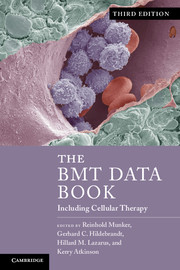Book contents
- Frontmatter
- Contents
- List of contributors
- Foreword
- Preface
- Acknowledgments
- Section 1 Basic science
- 1 Hematopoietic cell transplantation: past, present, and future
- 2 Basic science
- Section 2 Hematologic malignancies
- Section 3 Solid tumors
- Section 4 Nonmalignant disorders
- Section 5 Cellular therapy
- Section 6 Practical aspects and procedures
- Section 7 Complications
- Section 8 The BMT/SCT pharmacopoeia
- Section 9 HLA-testing and laboratory medicine
- Appendix Guide to the internet and literature databases relevant for BMT/SCT
- Index
- References
1 - Hematopoietic cell transplantation: past, present, and future
Published online by Cambridge University Press: 05 August 2013
- Frontmatter
- Contents
- List of contributors
- Foreword
- Preface
- Acknowledgments
- Section 1 Basic science
- 1 Hematopoietic cell transplantation: past, present, and future
- 2 Basic science
- Section 2 Hematologic malignancies
- Section 3 Solid tumors
- Section 4 Nonmalignant disorders
- Section 5 Cellular therapy
- Section 6 Practical aspects and procedures
- Section 7 Complications
- Section 8 The BMT/SCT pharmacopoeia
- Section 9 HLA-testing and laboratory medicine
- Appendix Guide to the internet and literature databases relevant for BMT/SCT
- Index
- References
Summary
The transplantation of hematopoietic stem cells (derived from the bone marrow of healthy donors) in the 1970s was considered a highly experimental procedure and was offered only to patients with late-stage leukemia. Later, it was recognized that only a small fraction of the transplanted cells were true stem cells and that the cure effected by allogeneic transplant was mediated by an immune reaction (graft-versus-leukemia reaction). In the last 20 or 30 years, hematopoietic cell transplantation (HCT) became a routine procedure both in the United States and worldwide. It is estimated that currently 60 000 or more patients globally undergo HCT every year. Overall, both allogeneic and autologous transplants have found their indications in the everyday practice of hematology/oncology. As can been seen in the following figures, allogeneic and autologous transplants have enjoyed a huge increase both in the United States and worldwide. In this book, the terms HCT, HSCT (hematopoietic stem cell transplantation), and HPCT (hematopoietic progenitor cell transplantation) will be used interchangeably.
Although the reporting of autologous transplants is voluntary, all accredited transplant centers in the United States submit data to the CIBMTR. Since 2007, when a Stem Cell Transplant Outcomes Database was created, the reporting of allogeneic transplants is mandatory in the United States. In previous years, unrelated transplants facilitated by the National Marrow Donor Program (NMDP) were reported through the NMDP. It was estimated by the CIBMTR that currently more than half of autologous transplants in the United States are reported to a registry.
- Type
- Chapter
- Information
- The BMT Data BookIncluding Cellular Therapy, pp. 1 - 6Publisher: Cambridge University PressPrint publication year: 2013



